Delosperma leendertziae
Delosperma leendertziae N.E.Br.
Family: Aizoaceae
Common names: Gauteng rock vygie, Gauteng sheepfig (Eng), klipvygie, rotsvygie (Afr).
Introduction
Delosperma leendertziae is a beautiful, dense and compact succulent with attractive, small yellow flowers that stand out throughout spring and summer. This species is a stunning groundcover that can be showcased in rocky succulent gardens.
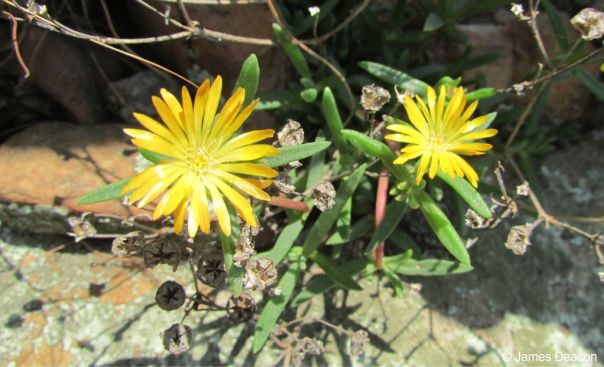
Description
Description
Delosperma leendertziae is a compact evergreen succulent groundcover. This plant grows up to 150 mm in height and 500-600 mm wide, forming bundled branches that are somehow erect. The leaves are fleshy, dark green to light green in colour, almost cylindrical, and tapering at both ends. The flowers are arranged in erect cymes with pedicels of 5-12 mm long. The flower heads have 10-25 petals that are bright yellow, often whitish on the lower parts towards the centre of the flower. The plant flowers in spring and summer, from September to May. The species has fragile fruits that are maroon with a funnel-shaped base. The fruit turns brown as they mature and dry, and the capsules eventually open to release seeds that are not covered by any membrane.
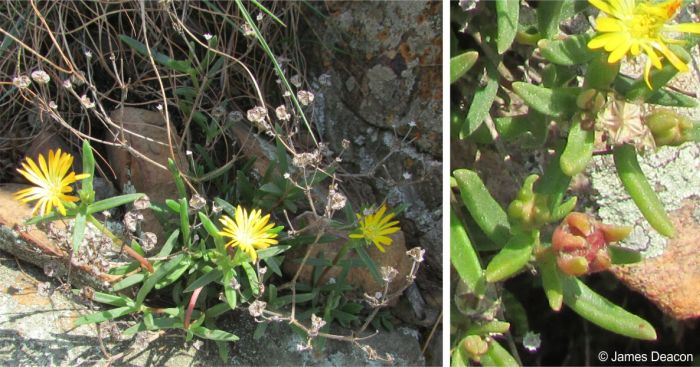
Conservation Status
Status
This species is assessed as Near Threatened (NT) by the Red List of South African Plants. The population is declining due to factors such as soil erosion, invasive alien plants and inappropriate fire management. It occurs over an area of 4-13 km², on steep quartzite slopes in mountain grassland, mostly in habitats at higher altitudes.
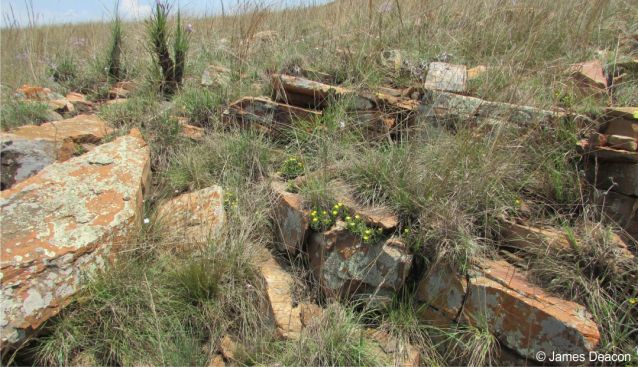
Distribution and habitat
Distribution description
Delosperma leendertziae is native to South Africa and it is distributed across the Gauteng province in Magaliesberg, Krugersdorp and Wonderboom, and it can also be found in the North West province around Rustenburg. Its habitat consists of rocky quartzite ridges in steep mountain grassland where it grows on south-facing slopes. Plants are mostly found growing in between rocky crevices on mountains. They thrive in well drained soils under full sun as they prefer warm temperatures and receive summer rainfall.
Derivation of name and historical aspects
History
Delosperma leendertziae, is a species that belongs to the Aizoaceae family and can be distinguished from other vygies in its habitat by its yellow flowers. Molecular evidence has raised doubts about the species status of Delosperma leendertziae and Delosperma vogtsii, sparking debate about whether they are a single species or two different species. In-depth observations and measurements of the elements in the flowers, to help differentiate the two species, as well as comparisons between both species show that while there is significant variation within the species in terms of both flower size and elements or features observed in the flowers they are still regarded as separate species.
The genus name Delosperma is derived from the Greek words delos, meaning evident or visible, and sperma, meaning seed. This refers to the exposed seeds of the plant that are visible in the fruiting capsule and are not covered by a membrane. The species is named after Miss Reino Leendertz (1869–1965) who was a botanist employed at the Transvaal Museum. She was the first to collect this species near Heidelberg, Gauteng, in 1909.
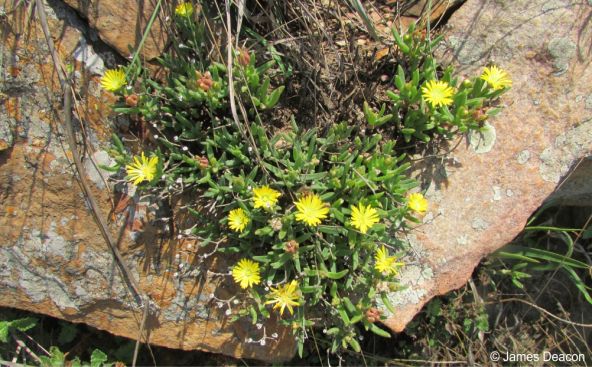
Ecology
Ecology
Delosperma leendertziae can be found on rocky ledges on steep, south facing slopes of quartzite, in mountain bushveld. Although the plant is a succulent and grows well in very hot and dry areas, it still requires summer rainfall to survive and flower. It grows in between rocks at high altitudes and on slopes and is thus able to survive and thrive in an environment that is exposed to high temperatures a lot of the time. The relatively small bright yellow, shallow bowl-shaped flowers attract pollinators such as bees and other pollinating insects. They flower over a long period, from spring through summer. When it rains, moisture causes the fruiting capsules to open, and as raindrops fall, they wash the seeds out of the capsules, releasing the seeds, which are then carried by the runoff to settle or get lodged in a crack, where they germinate.
Uses
Use
Delosperma leendertziae is a good addition to the garden because it attracts pollinators into the garden with its bright flowers and has the ability to reduce soil erosion levels with its low and sprawling stature. It is therefore frequently used as ground cover in rock gardens and can also be used on rock walls in landscaping. It can be used in waterwise and succulent gardens because of its tolerance for drought and low maintenance.
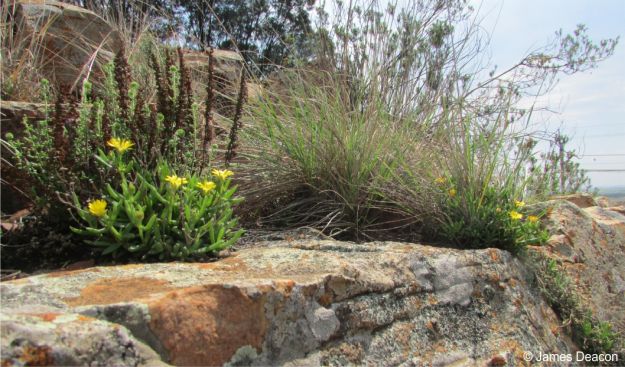
Growing Delosperma leendertziae
Grow
Delosperma is a genus of perennial plants that require very little maintenance and have huge garden potential because of their ability to survive in hot conditions and with less water than most plants. Delosperma plants will generally do well in full sun to semi-shade, in well-drained soil. As much as these plants are considered succulents, Delosperma plants originate from areas that have summer rainfall meaning they still need to be provided with plenty of water when they are in their growing and flowering season.
Delosperma leendertziae seeds should be harvested from the mature seed capsules in late summer before they fall off and disperse. The seeds should be sown in spring to autumn in shallow trays in sandy soil and covered with a thin layer of sand (1-2 mm). The soil medium should have good drainage but still be able to hold moisture, maintaining a somewhat damp but not soggy state to ensure successful germination. Until the seeds germinate, which should take about two to three weeks, seedling trays need to be kept in a warm and bright environment that has full sun. Once the seeds have germinated and the seedlings have emerged the plants should be transplanted into individual pots using a soil medium mixture that consists of 2 parts sand/perlite for drainage and 1 part potting soil for moisture retention.
Plants can be propagated from stem cuttings under controlled conditions in a greenhouse in winter, spring, or summer. The length of the cutting is best kept between 80 and 120 mm and planted in sandy soil. The bottom leaves should be removed such that the cutting only remains with 3-4 leaves to conserve energy for rooting and the stem cuttings should be planted about 30-40 mm deep in seedling trays of sand that should be kept moist at all times. Rooting will occur within 3 weeks when conditions are kept warm.
References
- Burgoyne, P. 2005. Delosperma N.E.Br. (Aizoaceae). PlantZAfrica. Online. https://pza.sanbi.org/delosperma.
- Hartmann, H.E.K. 2001. Illustrated handbook of succulent plants: Aizoaceae. Springer, Berlin.
- Hartmann, H.E.K. 2008. Delosperma in Gauteng: tracking down grassland mesembs: grasslands. Veld & Flora 94(4): 203-205.
- Hartmann, H.E.K. 2009. A revision of the species of Delosperma (Aizoaceae) in Gauteng, South Africa. Haseltonia 15: 59-65. https://doi.org/10.2985/026.015.0106.
- Latti, I. n.d. Delosperma leendertziae. Operation Wildflower. https://www.operationwildflower.net/index.php/albums/274-genera-d/66-delosperma/5327-delosperma-leendertziae-il-1-5327. Accessed on 2024/07/12.
- Van Jaarsveld, E. 2024. Delosperma frutescens L.Bolus (Aizoaceae). PlantZAfrica. Online. https://pza.sanbi.org/delosperma-frutescens.
- Victor, J.E & Pfab, M.F. 2005. Delosperma leendertziae N.E.Br. National Assessment: Red List of South African Plants. http://redlist.sanbi.org/species.php?species=137-96.
Credits
Neo Modise and Rofhiwa Ingrid Mudau
Pretoria National Botanical Garden
August 2025
Acknowledgements: images by James Deacon.
Plant Attributes:
Plant Type: Succulent
SA Distribution: Gauteng, North West
Soil type: Sandy
Flowering season: Spring, Early Summer, Late Summer
PH: Acid
Flower colour: Yellow
Aspect: Full Sun
Gardening skill: Average
Special Features:
Horticultural zones
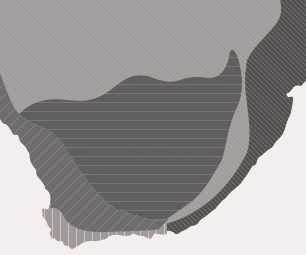







Rate this article
Article well written and informative
Rate this plant
Is this an interesting plant?
Login to add your Comment
Back to topNot registered yet? Click here to register.